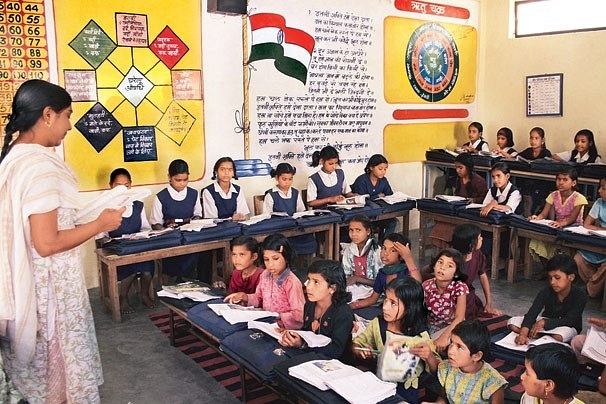News Brief
Pandemic Steered Shift Of Almost Forty Lakh Students To Government Schools

Students at a classroom in a government-run school.
Around 39.7 lakh students of government-aided, private school students shifted to Government schools in the last academic year, as per a release by the Ministry of Education (MOE).
The second pandemic year also saw an increase of 11.8 lakh girls enrolling in primary to higher secondary schools in comparison to the previous year taking the total to over 12.2 crore.
As per the findings of the Unified District Information System for Education Plus (UDISE+) 2020-21 on school education of India, there was also an increase of 28.32 lakh enrolments from primary to higher secondary school in 2020-2021. The total enrolments thereby stood at 25.38 crore against the 25.10 crore in 2019-20.
The Ministry of Education will be releasing a detailed report on the UDISE+ 2020-21, a system of online data collection from the schools that was developed by Department of School Education & Literacy in the year 2018-19 to overcome the issues related to erstwhile practice of manual data filling in paper format and subsequent feeding on computer at the block or district level in the UDISE data collection system since 2012-13.
The Gross Enrolment Ratio (GER) which measures the general level of participation has improved in 2020-21 at all levels of school education compared to 2019-20.
While the upper primary GER has increased to 92.2 per cent from 89.7 percent, in the elementary level it has risen from 97.8 per cent to 99.1 per cent. The GER of the secondary level and higher secondary level also saw a hike from 77.9 per cent in 2019-20 to 79.8 per cent, and from 51.4 per cent to 53.8 per cent resepctively in 2020-21.
There has also been an increase in the number of teachers engaged in school education during 2020-21. In comparison to its preceding year, an increase of around 8,800 teachers saw the total number reach 96.96 lakh teachers.
This in turn has seen an improvement in the Pupil Teacher Ratio (PTR) . The PTR stood at 26 for primary, 19 for upper primary, 18 for secondary and 26 for higher secondary, from the 28, 20, 21, and 30 respectively in 2018-19.
The number of non-teaching staffs has also improved over the years. Total non teaching staffs during 2020-21 stood at 15.8 lakh as compared to 12.37 lakhs in 2018-19.
In terms of school infrastructure too, there has been a ‘remarkable improvement’ in the number of schools with functional electricity across the country. From 73.85 per cent in 2018-18, a net addition of 57,799 schools has taken it to 84 per cent, while the percentage of the schools with functional drinking water has increased to 95.2 per cent in 2020-21 from 93.7 per cent in 2019-20.
Percentage of the school with functional girl’s toilet facility has increased to 93.91 per cent in 2020-21 in comparison with 93.2 per cent in 2019-20 as 11,933 schools added to the list.
Percentage of schools with hand wash facilities has also improved during 2020-21 and now stands at 91.9 per cent as compared to 90.2 per cent in 2019-20.
Support Swarajya's 50 Ground Reports Project & Sponsor A Story
Every general election Swarajya does a 50 ground reports project.
Aimed only at serious readers and those who appreciate the nuances of political undercurrents, the project provides a sense of India's electoral landscape. As you know, these reports are produced after considerable investment of travel, time and effort on the ground.
This time too we've kicked off the project in style and have covered over 30 constituencies already. If you're someone who appreciates such work and have enjoyed our coverage please consider sponsoring a ground report for just Rs 2999 to Rs 19,999 - it goes a long way in helping us produce more quality reportage.
You can also back this project by becoming a subscriber for as little as Rs 999 - so do click on this links and choose a plan that suits you and back us.
Click below to contribute.
Latest